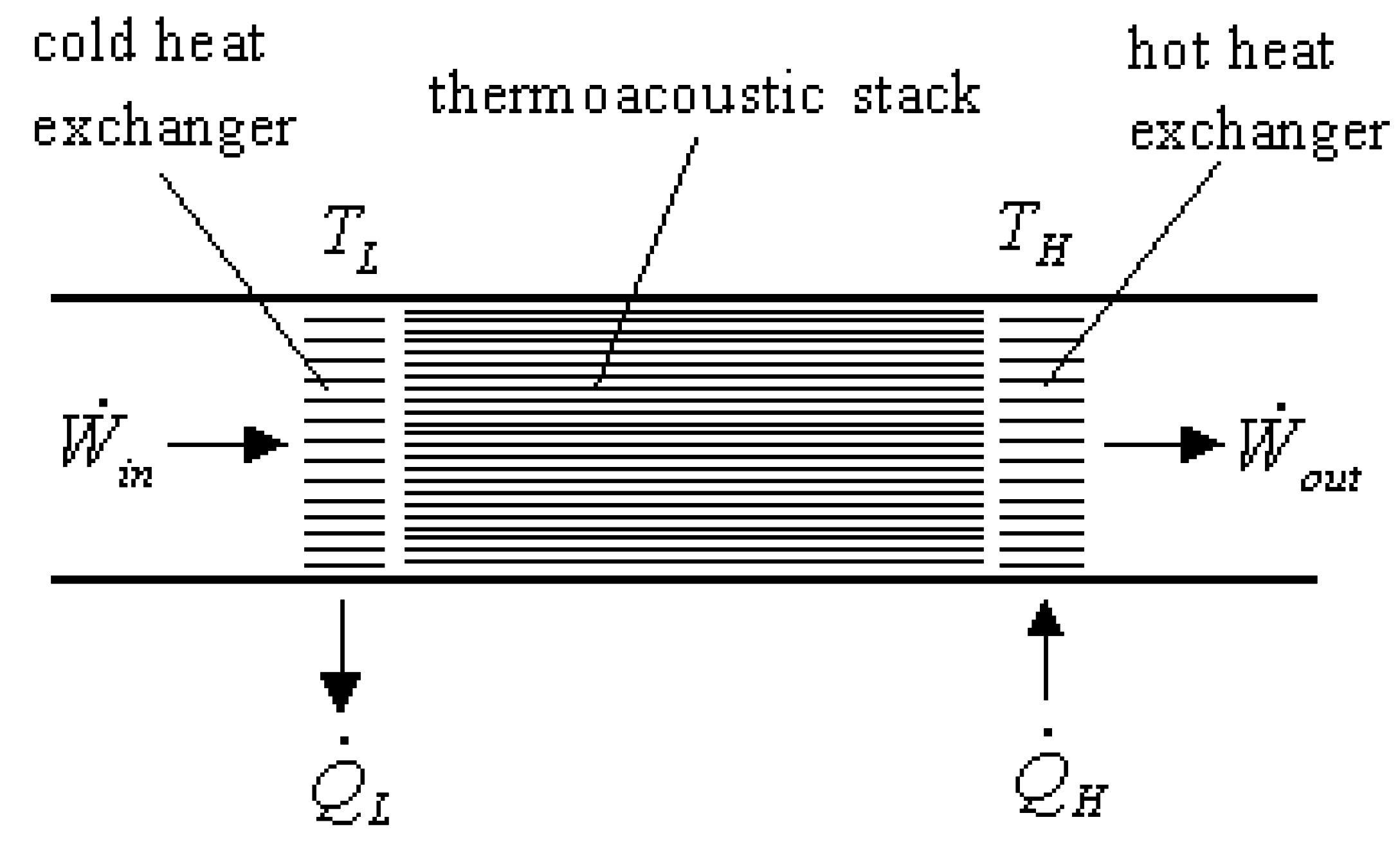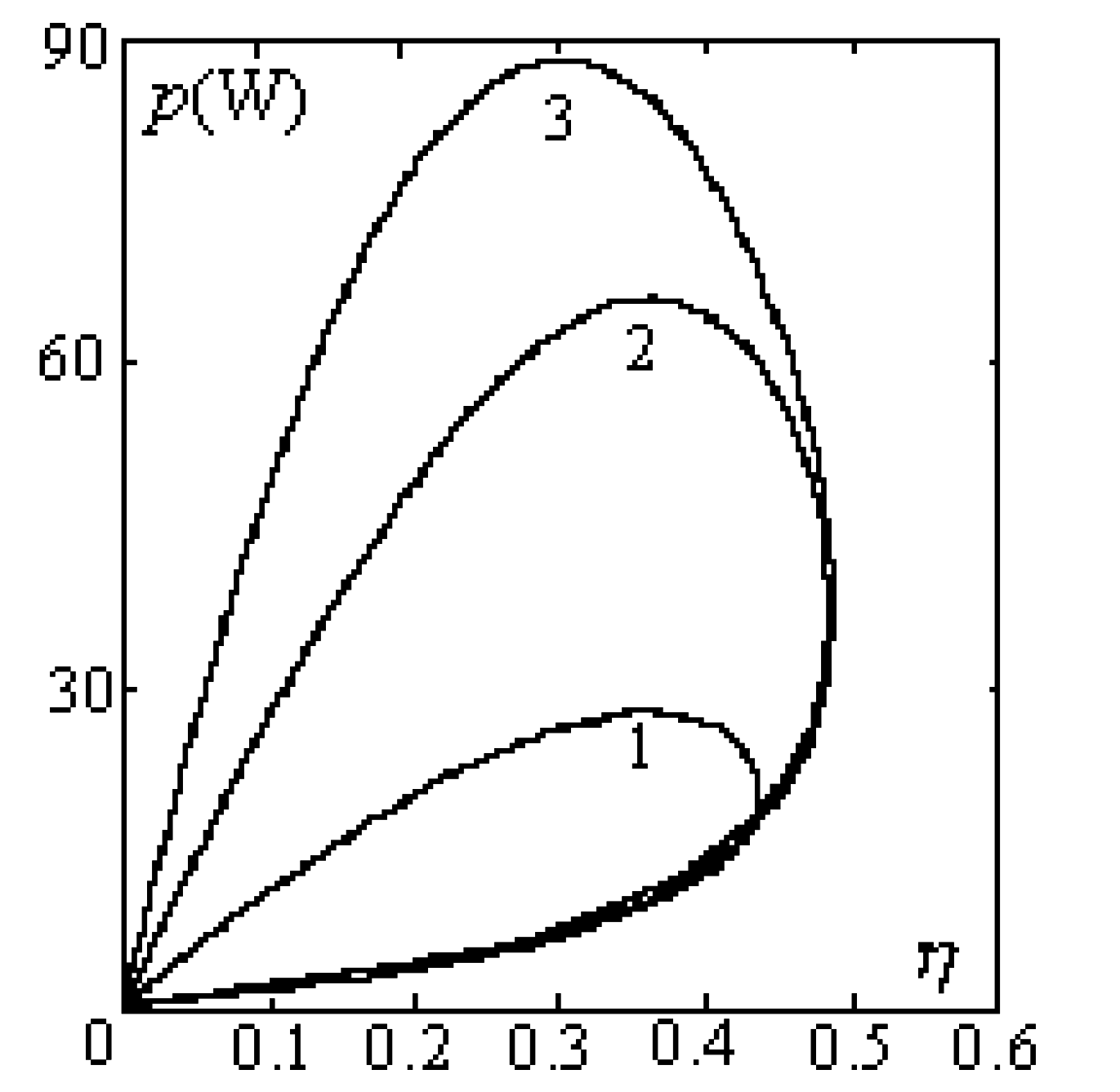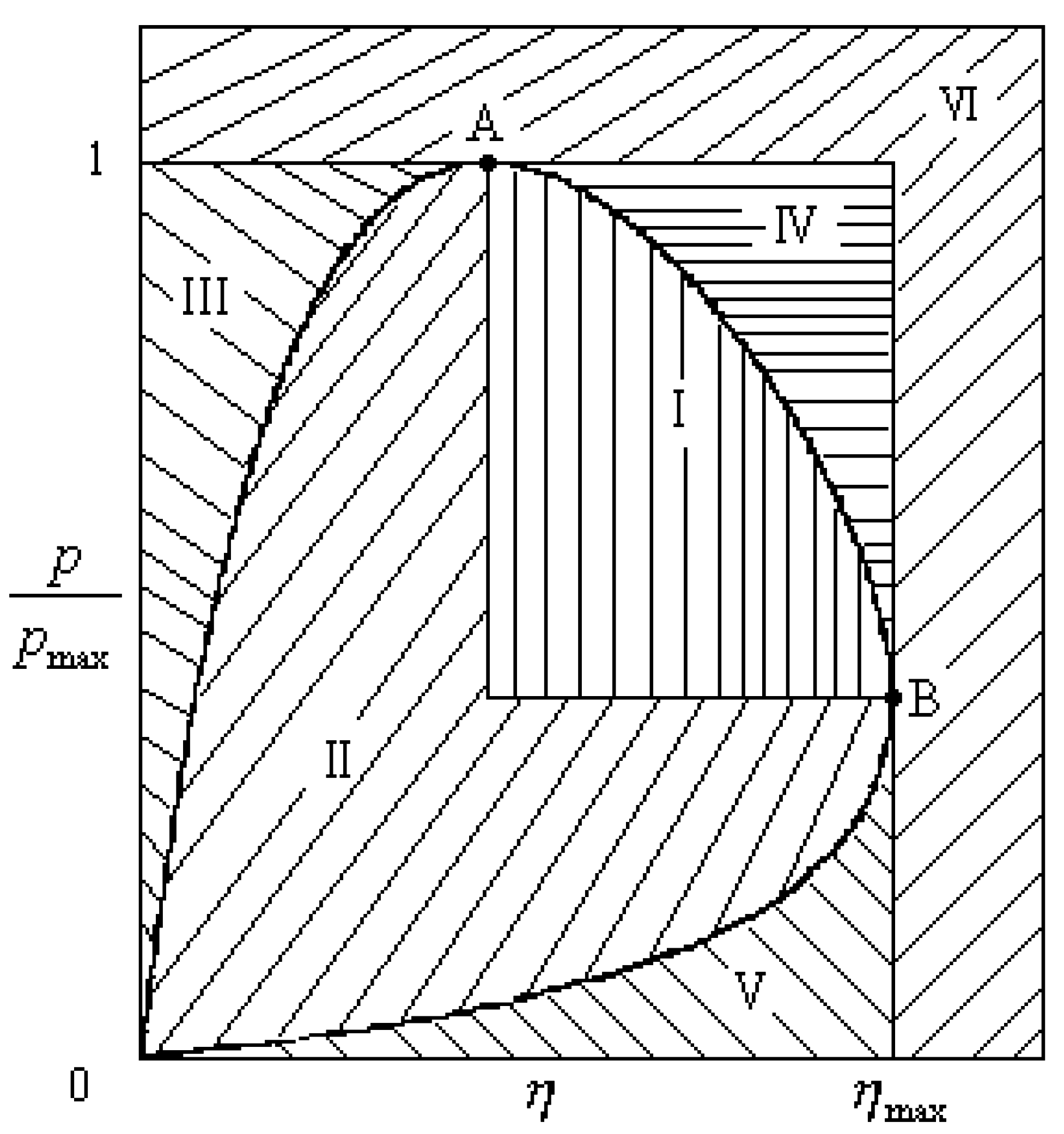Introduction
A thermoacoustic engine (prime mover and refrigerator) [
1,
2,
3,
4] is of the advantages of high reliability, low noise, simple construction, non-parts of motion, non-pollution, ability to self-start etc. It can utilize a wide variety of energy resources: solar, geothermal, industrial waste heat and marsh gas. It has very important significance for environmental protection and moderating the tense petroleum needs in the world. With this great potential, the thermoacoustic engine has captivated many engineers in the power and cryogenic engineering.
The power and efficiency be very important characteristics for energy conversion devices. Novikov [
5], Chambadal [
6], and Curzon and Ahlborn [
7] extended the Carnot cycle by taking account of the irreversibility of finite-time heat transfer. Their work which is commonly referred to as finite-time thermodynamics (FTT) or entropy generation minimization, has been undertaken by many researchers. Some authors have assessed the effect of the heat transfer law on the performance of endoreversible [
8,
9] and irreversible [
10,
11] heat engines and coolers. In these works, the heat transfer exponent is assumed to be real.
Modern heat transfer models account for many details of fluid motion, interaction between temperature field and acoustic field, and system geometry. For a thermoacoustec engine (or refrigerator), the interactions between the entropy wave and the oscillating flow produce a rich variety of thermoacoustic phenomena such as self-excited gas oscillation [
12]. A longitudinal pressure oscillating in the sound channel induces a temperature oscillating in time at angular frequency
. In the circumstances the gas temperature is complex. The method of complex temperature often used in periodic conduction problems. It results in a heat transfer with complex exponent.
A complex Nusselt number to heat transfer in a cylinder have been studied by Kornhauser [
13] by using Newton’s linear law of convection with complex temperature. In general, heat transfer is not necessarily linear. This paper will use a generalized heat transfer law
, where
n is complex, to find the power versus efficiency characteristics of the thermoacoustic heat engine. The effect of heat leakage, internal irreversibility is considered in this paper.
Thermoacoustic engine model
Essentially, a thermoacoustic engine consists of heat exchangers, thermoacoustic stack (or thermoacoustic regenerator) and working fluid gas. The energy flows in the apparatus is schematically illustrated in
Fig.1. Heat was supplied to the engine by hot heat exchanger, and waste heat was removed by cold heat exchanger, delivering acoustic power (
) to the outside of system. The following assumptions are made for this model.
Fig.1.
Energy flows in a therm o acoustic engine
Fig.1.
Energy flows in a therm o acoustic engine
(i)There exist external irreversibilities due to heat transfer in the hot and the cold heat exchangers between the engine and its surrounding heat reservoirs. Because of the heat transfer, the time average temperatures (
TH0 and
TL0) of the working fluid are different from the reservoir temperatures (
TH and
TL). The second law of thermodynamics requires
TH >
TH0 >
TL0 >
TL. As a result of thermoacoustic oscillating, the temperatures (
THc and
TLc) of the working fluid can be expressed as complexes:
where
T1 and
T2 are the first-order acoustic quantities,
,
is the oscillating angular frequency. Here the reservoir temperatures (
TH and
TL) are assumed as real constants, so they have no imaginary part.
(ii)Consider that the heat transfer between the engine and its surroundings follow a generalized law (
), Then
where
is a complex heat transfer exponent,
is the overall heat transfer coefficient and F
1 is the heat transfer surface area of the hot heat exchanger,
is the overall heat transfer coefficient and F
2 is the heat transfer surface area of the cold heat exchanger.
and
have negative values if
. Here the imaginary part
n2 of n indicates the relaxation of a heat transfer process. Equations (3) and (4) can be rewritten as
where
and
are the time average of
and
, respectively.
The heat-transfer surface areas (
F1 and
F2) of the hot and cold heat exchangers are finite. The total heat transfer surface area (
F) of the two heat exchangers is assumed to be a constant
(iii)There exists a rate of heat leakage (
) from the heat source to the heat sink [
14]. It is assumed as a constant [
10]. Thus
where
is rate of heat transfer supplied by the heat source and
is rate of heat transfer released to the heat sink.
(iv)In addition to heat resistance between the working substance and the heat reservoirs, heat leakage between the heat reservoirs, there are internal irreversibilities in the system due to miscellaneous factors such as friction and non-equilibrium activities inside the engine. The power output produced by the irreversible thermoacoustic engine is less than that of the endoreversible thermoacoustic engine with the same heat input. In other words, the rate of heat flow (
) from the cold working fluid to the heat sink for the irreversible thermoacoustic engine is larger than that for the endoreversible thermoacoustic engine (
). The factor
of internal irreversible degree to characterize the additional internal miscellaneous irreversibility effect is defined as follows
Optimal characteristics
For an endoreversible thermoacoustic engine, the second law of thermodynamics requires that
Combining equations (10) and (11) yields
The first law of thermodynamics gives that the power output of the engine is
The efficiency of the engine is
We define the heat transfer surface area ratio and working fluid temperature ratio as follows
From equations (5)-(9) and (12)-(16), we obtain the complex power output (
) and the complex efficiency (
) of the engine
The real part of the power output of the engine is
with
,
. Here
and
indicate the real part and imaginary part of complex number. The real part of the efficiency of the engine is
with
,
.
Eqs. (19) and (20) indicate that both power output
P and efficiency
of the engine are functions of the heat transfer surface area ratio (
f) for given
TH,
TL,
,
,
n1,
n2,
,
and
x. Taking the derivatives of
and
with respect to
f and setting them equal zero (
and
), we can find that when
f satisfies the following equation
both power output
and efficiency
approach optimal values
with
The parameter equation defined by equations (22) and (23) gives the fundamental relation between the optimal power output and efficiency for given TH, TL, , , n1, n2, , , and F. It is the main result of this paper.







